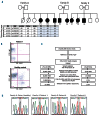Combined immunodeficiency with life-threatening EBV-associated lymphoproliferative disorder in patients lacking functional CD27
- PMID: 22801960
- PMCID: PMC3659923
- DOI: 10.3324/haematol.2012.068791
Combined immunodeficiency with life-threatening EBV-associated lymphoproliferative disorder in patients lacking functional CD27
Abstract
CD27, a tumor necrosis factor receptor family member, interacts with CD70 and influences T-, B- and NK-cell functions. Disturbance of this axis impairs immunity and memory generation against viruses including Epstein Barr virus (EBV), influenza, and others. CD27 is commonly used as marker of memory B cells for the classification of B-cell deficiencies including common variable immune deficiency. Flow cytometric immunophenotyping including expression analysis of CD27 on lymphoid cells was followed by capillary sequencing of CD27 in index patients, their parents, and non-affected siblings. More comprehensive genetic analysis employed single nucleotide polymorphism-based homozygosity mapping and whole exome sequencing. Analysis of exome sequencing data was performed at two centers using slightly different data analysis pipelines, each based on the Genome Analysis ToolKit Best Practice version 3 recommendations. A comprehensive clinical characterization was correlated to genotype. We report the simultaneous confirmation of human CD27 deficiency in 3 independent families (8 patients) due to a homozygous mutation (p. Cys53Tyr) revealed by whole exome sequencing, leading to disruption of an evolutionarily conserved cystein knot motif of the transmembrane receptor. Phenotypes varied from asymptomatic memory B-cell deficiency (n=3) to EBV-associated hemophagocytosis and lymphoproliferative disorder (LPD; n=3) and malignant lymphoma (n=2; +1 after LPD). Following EBV infection, hypogammaglobulinemia developed in at least 3 of the affected individuals, while specific anti-viral and anti-polysaccharide antibodies and EBV-specific T-cell responses were detectable. In severely affected patients, numbers of iNKT cells and NK-cell function were reduced. Two of 8 patients died, 2 others underwent allogeneic hematopoietic stem cell transplantation successfully, and one received anti-CD20 (rituximab) therapy repeatedly. Since homozygosity mapping and exome sequencing did not reveal additional modifying factors, our findings suggest that lack of functional CD27 predisposes towards a combined immunodeficiency associated with potentially fatal EBV-driven hemo-phagocytosis, lymphoproliferation, and lymphoma development.
Figures

Similar articles
-
CD27 deficiency is associated with combined immunodeficiency and persistent symptomatic EBV viremia.J Allergy Clin Immunol. 2012 Mar;129(3):787-793.e6. doi: 10.1016/j.jaci.2011.11.013. Epub 2011 Dec 24. J Allergy Clin Immunol. 2012. PMID: 22197273 Free PMC article.
-
Combined immunodeficiency and Epstein-Barr virus-induced B cell malignancy in humans with inherited CD70 deficiency.J Exp Med. 2017 Jan;214(1):91-106. doi: 10.1084/jem.20160849. Epub 2016 Dec 23. J Exp Med. 2017. PMID: 28011864 Free PMC article.
-
Novel mutations in TNFRSF7/CD27: Clinical, immunologic, and genetic characterization of human CD27 deficiency.J Allergy Clin Immunol. 2015 Sep;136(3):703-712.e10. doi: 10.1016/j.jaci.2015.02.022. Epub 2015 Apr 3. J Allergy Clin Immunol. 2015. PMID: 25843314
-
When to suspect inborn errors of immunity in Epstein-Barr virus-related lymphoproliferative disorders.Clin Microbiol Infect. 2023 Apr;29(4):457-462. doi: 10.1016/j.cmi.2022.10.003. Epub 2022 Oct 6. Clin Microbiol Infect. 2023. PMID: 36209991 Free PMC article. Review.
-
B lymphocytes and Epstein-Barr virus: the lesson of post-transplant lymphoproliferative disorders.Autoimmun Rev. 2007 Dec;7(2):96-101. doi: 10.1016/j.autrev.2007.02.012. Epub 2007 Mar 26. Autoimmun Rev. 2007. PMID: 18035317 Review.
Cited by
-
Specific Immune Response and Cytokine Production in CD70 Deficiency.Front Pediatr. 2021 Apr 30;9:615724. doi: 10.3389/fped.2021.615724. eCollection 2021. Front Pediatr. 2021. PMID: 33996677 Free PMC article.
-
Immunosuppressive therapy with rituximab in common variable immunodeficiency.Clin Mol Allergy. 2019 May 6;17:9. doi: 10.1186/s12948-019-0113-3. eCollection 2019. Clin Mol Allergy. 2019. PMID: 31080365 Free PMC article. Review.
-
Molecular Classification of Primary Immunodeficiencies of T Lymphocytes.Adv Immunol. 2018;138:99-193. doi: 10.1016/bs.ai.2018.02.003. Epub 2018 Mar 29. Adv Immunol. 2018. PMID: 29731008 Free PMC article. Review.
-
Extended clinical and immunological phenotype and transplant outcome in CD27 and CD70 deficiency.Blood. 2020 Dec 3;136(23):2638-2655. doi: 10.1182/blood.2020006738. Blood. 2020. PMID: 32603431 Free PMC article. Clinical Trial.
-
Epstein-Barr virus infection transforms CD25+ B cells into antibody-secreting cells in rheumatoid arthritis patients.Immunology. 2013 Dec;140(4):421-9. doi: 10.1111/imm.12151. Immunology. 2013. PMID: 23844744 Free PMC article.
References
-
- Bigler RD, Bushkin Y, Chiorazzi N. S152 (CD27). A modulating disulfide-linked T cell activation antigen. J Immunol. 1988; 141(1):21–8 - PubMed
-
- Camerini D, Walz G, Loenen WA, Borst J, Seed B. The T cell activation antigen CD27 is a member of the nerve growth factor/tumor necrosis factor receptor gene family. J Immunol. 1991;147(9):3165–9 - PubMed
-
- Gravestein LA, Amsen D, Boes M, Calvo CR, Kruisbeek AM, Borst J. The TNF receptor family member CD27 signals to Jun N-terminal kinase via Traf-2. Eur J Immunol. 1998;28(7):2208–16 - PubMed
-
- Hendriks J, Gravestein LA, Tesselaar K, van Lier RA, Schumacher TN, Borst J. CD27 is required for generation and long-term maintenance of T cell immunity. Nat Immunol. 2000;1(5):433–40 - PubMed
-
- Nolte MA, van Olffen RW, van Gisbergen KP, van Lier RA. Timing and tuning of CD27–CD70 interactions: the impact of signal strength in setting the balance between adaptive responses and immunopathology. Immunol Rev. 2009;229(1):216–31 - PubMed
Publication types
MeSH terms
Substances
Grants and funding
LinkOut - more resources
Full Text Sources
Other Literature Sources
Molecular Biology Databases
Research Materials

